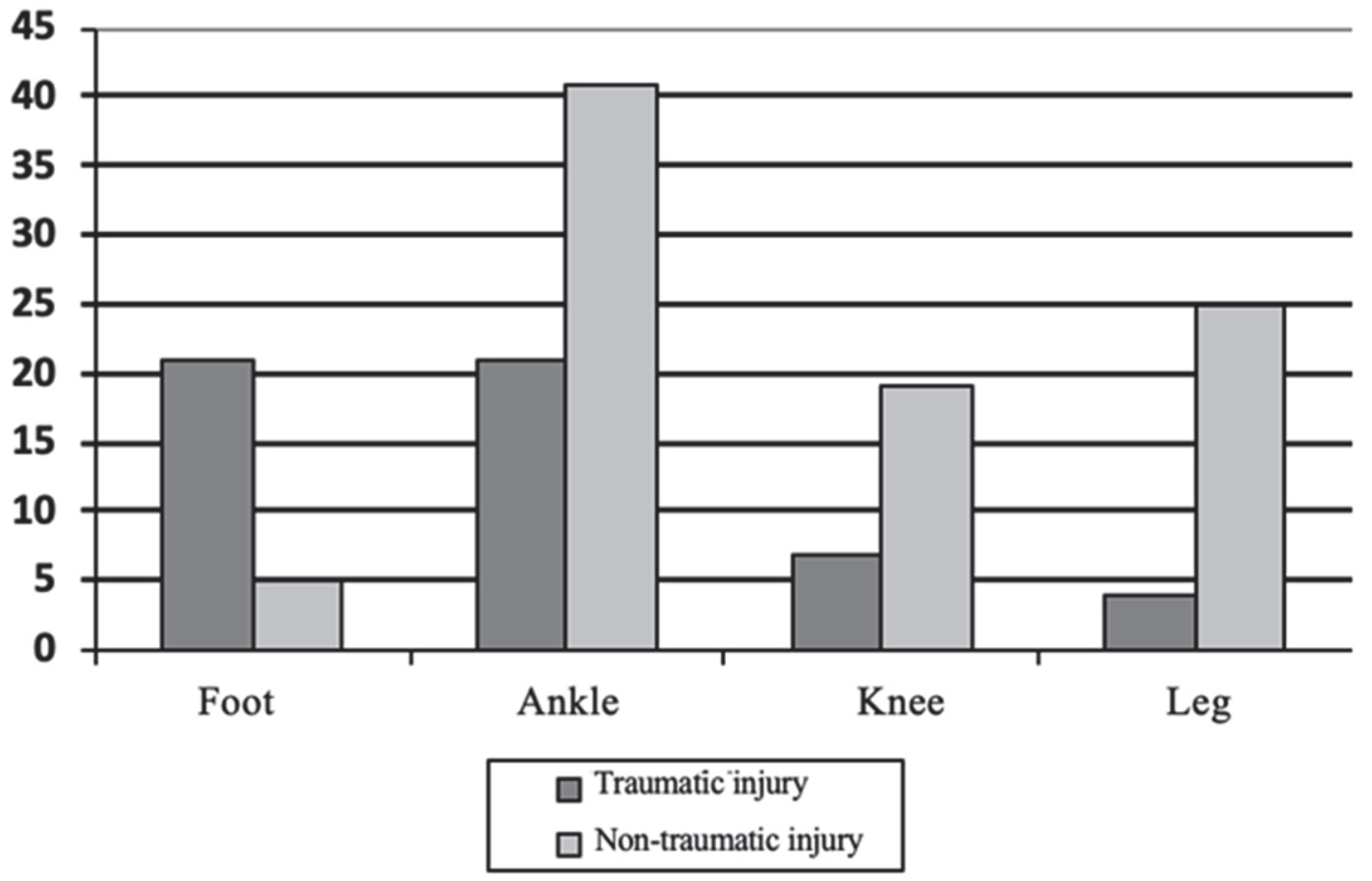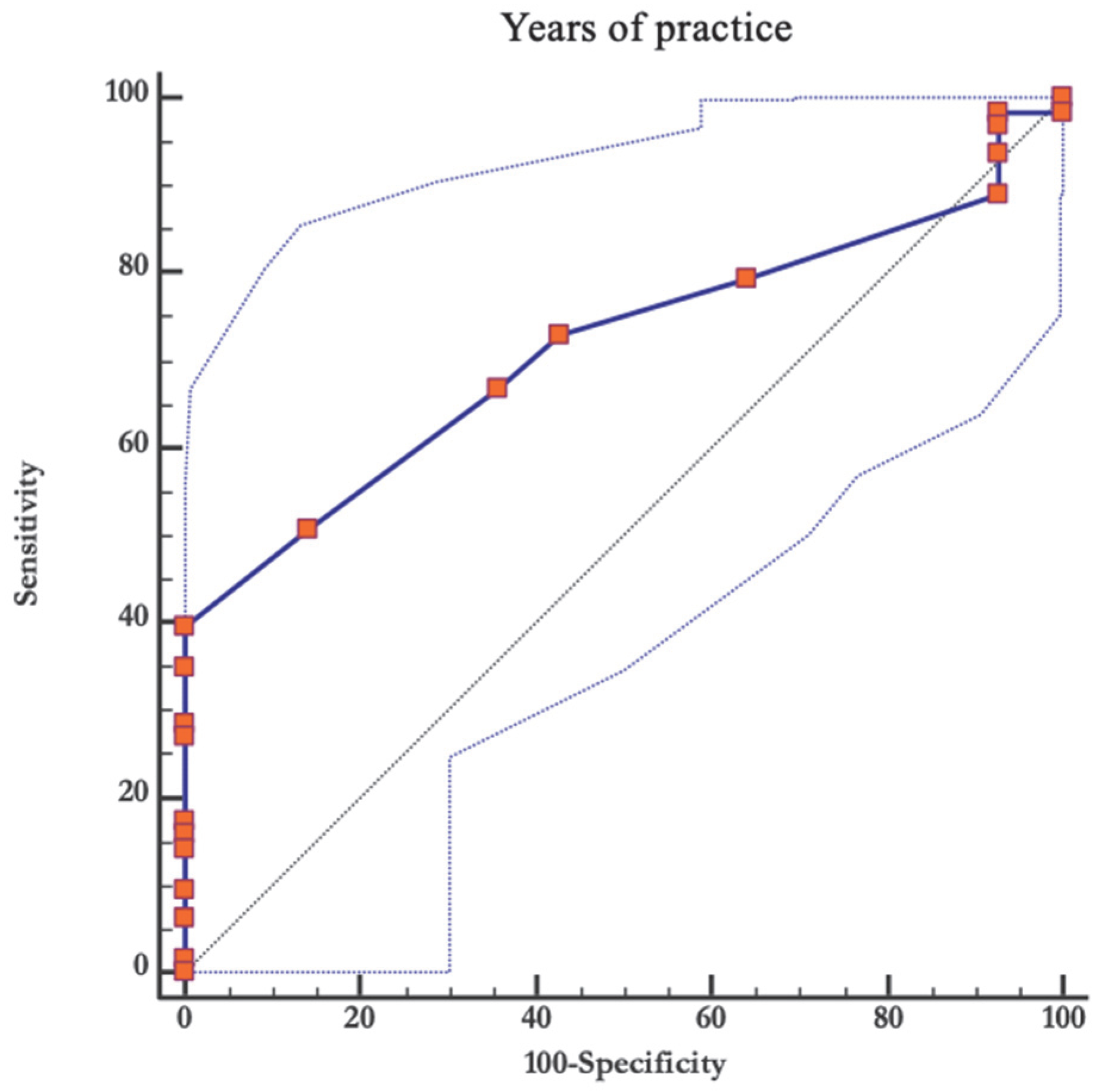The Influence of Stud Characteristics of Football Boots Regarding Player Injuries
Abstract
1. Introduction
2. Materials and Methods
2.1. Procedure
2.2. Statistical Analysis
3. Results
4. Discussion
5. Conclusions
Author Contributions
Funding
Institutional Review Board Statement
Informed Consent Statement
Data Availability Statement
Conflicts of Interest
References
- Herrero, H.; Salinero, J.J.; Del Coso, J. Injuries among spanish male amateur soccer players: A retrospective population study. Am. J. Sports Med. 2014, 42, 78–85. [Google Scholar] [CrossRef] [PubMed]
- Okholm Kryger, K.; Mutamba, K.; Mitchell, S.; Miller, S.C.; Forrester, S. Physical Performance and Perception of Foot Discomfort during a Soccer-Specific Match Simulation. A Comparison of Football Boots. J. Sports Sci. 2021, 39, 1046–1054. [Google Scholar] [CrossRef]
- Wong, P.; Hong, Y. Soccer injury in the lower extremities. Br. J. Sports Med. 2005, 39, 473–482. [Google Scholar] [CrossRef] [PubMed]
- Butler, R.J.; Russell, M.E.; Queen, R. Effect of soccer footwear on landing mechanics. Scand. J. Med. Sci. Sports 2014, 24, 129–135. [Google Scholar] [CrossRef] [PubMed]
- Hennig, E.M. The influence of soccer shoe design on player performance and injuries. Res. Sport. Med. 2011, 19, 186–201. [Google Scholar] [CrossRef] [PubMed]
- Waldén, M.; Hägglund, M.; Ekstrand, J. UEFA Champions League study: A prospective study of injuries in professional football during the 2001-2002 season. Br. J. Sports Med. 2005, 39, 542–546. [Google Scholar] [CrossRef]
- Bentley, J.A.; Ramanathan, A.K.; Arnold, G.P.; Wang, W.; Abboud, R.J. Harmful cleats of football boots: A biomechanical evaluation. Foot Ankle Surg. 2011, 17, 140–144. [Google Scholar] [CrossRef] [PubMed]
- Kulessa, D.J.; Gollhofer, A.; Gehring, D. The influence of football shoe characteristics on athletic performance and injury risk–a review. Footwear Sci. 2017, 9, 49–63. [Google Scholar] [CrossRef]
- Thomson, A.; Whiteley, R.; Wilson, M.; Bleakley, C. Six different football shoes, one playing surface and the weather; Assessing variation in shoe-surface traction over one season of elite football. PLoS ONE 2019, 14, e0216364. [Google Scholar] [CrossRef]
- Lv, X.; He, Y.; Sun, D.; Baker, J.S.; Xuan, R.; Gu, Y. Effect of stud shape on lower limb kinetics during football-related movements. Proc. Inst. Mech. Eng. Part P J. Sport. Eng. Technol. 2020, 234, 3–10. [Google Scholar] [CrossRef]
- Villwock, M.R.; Meyer, E.G.; Powell, J.W.; Fouty, A.J.; Haut, R.C. Football playing surface and shoe design affect rotational traction. Am. J. Sports Med. 2009, 37, 518–525. [Google Scholar] [CrossRef] [PubMed]
- Müller, C.; Sterzing, T.; Lange, J.; Milani, T.L. Comprehensive evaluation of player-surface interaction on artificial soccer turf. Sports Biomech. 2010, 9, 193–205. [Google Scholar] [CrossRef] [PubMed]
- De Clercq, D.; Debuyck, G.; Gerlo, J.; Rambour, S.; Segers, V.; Van Caekenberghe, I. Cutting performance wearing different studded soccer shoes on dry and wet artificial turf. Footwear Sci. 2014, 6, 81–87. [Google Scholar] [CrossRef]
- Sun, D.; Gu, Y.; Mei, Q.; Baker, J.S. Different soccer stud configurations effect on running and cutting movements. Int. J. Biomed. Eng. Technol. 2017, 24, 19–32. [Google Scholar] [CrossRef]
- Marfell-Jones, M.; Stewart, A.; De Ridder, J. International Standards for Anthropometric Assessment; International Society for the Advancement of Kinanthropometry: Glasgow, UK, 2012. [Google Scholar]
- Junge, A.; Dvorak, J.; Graf-Baumann, T.; Peterson, L. Football Injuries during FIFA Tournaments and the Olympic Games, 1998-2001: Development and Implementation of an Injury-Reporting System. Am. J. Sports Med. 2004, 32, 1998–2001. [Google Scholar] [CrossRef]
- Soderman, K.; Adolphson, J.; Lorentzon, R.; Alfredson, H. Injuries in adolescent female players in European football: A prospective study over one outdoor soccer season/Blessures chez les adolescentes jouant au football en Europe: Etude prospective sur une saison de football en plein air. Scand. J. Med. Sci. Sports 2001, 11, 299–304. [Google Scholar] [CrossRef]
- Murray, D.; Jain, N.P.M.; Kemp, S.; McEvoy, T. Foot and ankle injuries in elite professional footballers: The findings of one English Premier League team. Inj. Extra 2011, 42, 159–160. [Google Scholar] [CrossRef]
- Sterzing, T.; Müller, C.; Hennig, E.M.; Milani, T.L. Actual and perceived running performance in soccer shoes: A series of eight studies. Footwear Sci. 2009, 1, 5–17. [Google Scholar] [CrossRef]
- Anbarian, M.; Esmaeili, H. Effects of running-induced fatigue on plantar pressure distribution in novice runners with different foot types. Gait Posture 2016, 48, 52–56. [Google Scholar] [CrossRef]
- Andersen, T.E.; Floerenes, T.W.; Arnason, A.; Bahr, R. Video Analysis of the Mechanisms for Ankle Injuries in Football. Am. J. Sports Med. 2004, 32, 69–79. [Google Scholar] [CrossRef]
- Henry, T.; Evans, K.; Snodgrass, S.J.; Miller, A.; Callister, R. Risk Factors for Noncontact Ankle Injuries in Amateur Male Soccer Players: A Prospective Cohort Study. Clin. J. Sport Med. 2016, 26, 251–258. [Google Scholar] [CrossRef] [PubMed]
- Svensson, K.; Alricsson, M.; Karnebäck, G.; Magounakis, T.; Werner, S. Muscle injuries of the lower extremity: A comparison between young and old male elite soccer players. Knee Surgery, Sport. Traumatol. Arthrosc. 2016, 24, 2293–2299. [Google Scholar] [CrossRef] [PubMed]


| Variables | Total Sample Mean ± SD | Amateur Mean ± SD | Semi-Professional Mean ± SD |
|---|---|---|---|
| Age (years) | 23.14 ± 4.8 | 24.87 ± 4.74 | 21.98 ± 4.52 |
| Height (cm) | 177.5 ± 0.07 | 175.68 ± 0.64 | 178.8 ± 0.6 |
| Body mass (kg) | 75.5 ± 10.64 | 77.36 ± 14.21 | 74.24 ± 7.24 |
| Body mass index (kg/m2) | 25.01 ± 3.19 | 25.05 ± 4.33 | 23.21 ± 1.8 |
| Years of practice (years) | 15.68 ± 4.65 | 15.97 ± 6.26 | 15.5 ± 3.2 |
| Boot Replacement (months) | 6.45 ± 5.07 | 10.1 ± 5.65 | 4 ± 2.6 |
| Visual Analogic Scale | 1.32 ± 1.72 | 1.77 ± 2.18 | 2.05 ± 2.43 |
| Foot Posture Index (Right) | 1.96 ± 2.91 | 2.58 ± 2.17 | 1.52 ± 3.27 |
| Foot Posture Index (Left) | 1.65 ± 3.07 | 2 ± 2.06 | 1.41 ± 3.6 |
| Number of Boot Studs (per zone) | |||
| Rearfoot | 4.53 ± 1.09 | 4.54 ± 1.06 | 4.52 ± 1.11 |
| Lateral rearfoot | 2.23 ± 0.62 | 2.25 ± 0.6 | 2.22 ± 0.62 |
| Medial rearfoot | 2.17 ± 0.48 | 2.17 ± 0.38 | 2.17 ± 0.52 |
| Midfoot | 0.16 ± 0.5 | 0 ± 0 | 0.24 ± 0.6 |
| 5th metatarsal | 2.26 ± 0.67 | 2.25 ± 0.73 | 2.26 ± 0.64 |
| 1st metatarsal | 2.34 ± 1.01 | 2.04 ± 0.8 | 2.5 ± 1.07 |
| Central metatarsals | 1.59 ± 1.14 | 1.75 ± 1.03 | 1.5 ± 1.18 |
| Toes | 3.57 ± 1.75 | 4.21 ± 1.74 | 3.24 ± 1.67 |
| Type of Surface | |||
| Artificial Grass | 38 | 20 | 18 |
| Natural Grass | 28 | 0 | 28 |
| Land | 11 | 11 | 0 |
| Type of Stud | |||
| Knife | 6 | 2 | 4 |
| Rounded | 44 | 21 | 23 |
| Triangular | 23 | 8 | 15 |
| Mixed | 4 | 0 | 4 |
| Years of Practice | Toes Studs | Medial Rearfoot Studs | Lateral Rearfoot Studs | |||||||||
|---|---|---|---|---|---|---|---|---|---|---|---|---|
| Dependent Variables | R2 | B (SE) | p | R2 | B (SE) | p | R2 | B (SE) | p | R2 | B (SE) | p |
| Total Injuries [lower limb] | 0.66 | 0.085 (0.039) | 0.031 | |||||||||
| R2 adjusted | 0.053 | |||||||||||
| Overload Injuries [ankle] | 0.058 | 0.023 (0.011) | 0.046 | |||||||||
| R2 adjusted | 0.044 | |||||||||||
| Overload Injuries [foot] Model 1 | 0.213 | 0.115 (0.027) | 0.000 | |||||||||
| R2 adjusted | 0.201 | |||||||||||
| Overload Injuries [foot] Model 2 | 0.406 | 0.285 (0.043) | 0.000 | 0.406 | −0.158 (0.034) | 0.000 | ||||||
| R2 adjusted | 0.388 | |||||||||||
Disclaimer/Publisher’s Note: The statements, opinions and data contained in all publications are solely those of the individual author(s) and contributor(s) and not of MDPI and/or the editor(s). MDPI and/or the editor(s) disclaim responsibility for any injury to people or property resulting from any ideas, methods, instructions or products referred to in the content. |
© 2022 by the authors. Licensee MDPI, Basel, Switzerland. This article is an open access article distributed under the terms and conditions of the Creative Commons Attribution (CC BY) license (https://creativecommons.org/licenses/by/4.0/).
Share and Cite
Castillo-Domínguez, A.; Torrontegui-Duarte, M.; Páez-Moguer, J.; Gómez-del-Pino, Á.; Cervera-Garvi, P.; Mainer-Pardos, E.; Lozano, D.; García-Romero, J. The Influence of Stud Characteristics of Football Boots Regarding Player Injuries. Int. J. Environ. Res. Public Health 2023, 20, 720. https://doi.org/10.3390/ijerph20010720
Castillo-Domínguez A, Torrontegui-Duarte M, Páez-Moguer J, Gómez-del-Pino Á, Cervera-Garvi P, Mainer-Pardos E, Lozano D, García-Romero J. The Influence of Stud Characteristics of Football Boots Regarding Player Injuries. International Journal of Environmental Research and Public Health. 2023; 20(1):720. https://doi.org/10.3390/ijerph20010720
Chicago/Turabian StyleCastillo-Domínguez, Alejandro, Marcelino Torrontegui-Duarte, Joaquín Páez-Moguer, Álvaro Gómez-del-Pino, Pablo Cervera-Garvi, Elena Mainer-Pardos, Demetrio Lozano, and Jerónimo García-Romero. 2023. "The Influence of Stud Characteristics of Football Boots Regarding Player Injuries" International Journal of Environmental Research and Public Health 20, no. 1: 720. https://doi.org/10.3390/ijerph20010720
APA StyleCastillo-Domínguez, A., Torrontegui-Duarte, M., Páez-Moguer, J., Gómez-del-Pino, Á., Cervera-Garvi, P., Mainer-Pardos, E., Lozano, D., & García-Romero, J. (2023). The Influence of Stud Characteristics of Football Boots Regarding Player Injuries. International Journal of Environmental Research and Public Health, 20(1), 720. https://doi.org/10.3390/ijerph20010720









